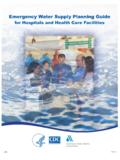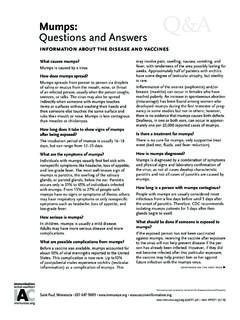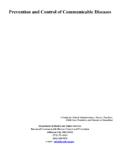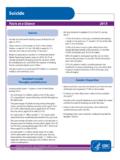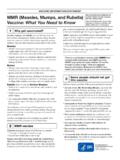Transcription of Edition - WHO
1 Primary Containment for Biohazards: Selection, Installation and Use of Biological Safety Cabinets 2nd Edition Department of Health and Human Services Public Health Service centers for disease control and prevention and National Institutes of Health September 2000. GOVERNMENT PRINTING OFFICE. WASHINGTON: 2000. EDITORS: Jonathan Y. Richmond, Director, Office of Health and Safety centers for disease control and prevention Atlanta, GA 30333. Robert W. McKinney, Director, Division of Safety National Institutes of Health Bethesda, MD 20892. i CONTRIBUTORS: centers for disease control and prevention Office of Health and Safety Richard Green Henry Mathews, Training Activity Laboratory Safety Branch Richard Knudsen, Michael W eathers Laboratory Safety Branch Laboratory Safety Branch National Institutes of Health Division of Safety Edwa rd F.
2 Sor ensen III Ronald Trower Occupational Safety and Occupational Safety and Health Branch Health Branch Michael L. Spillane Deborah E. Wilson, Occupational Safety and Occupational Safety and Health Branch Health Branch Other Contributors: Lee M. Alderman Jonathan Crane Emory University 1201 Peachtree Street, NE. Atlanta, GA 400 Colony Square, Ste 600. Atlanta, GA 30361-3500. Manuel S. Barbeito F rede ri ck , M D Diane O. Fleming, B o w ie , M D. David G. Stuart, The Baker Company S a nf o rd , ME. ii CONTENTS. SECTION I. Introduction .. 1. SECTION II. The High Efficiency Particulate Air (HEPA) Filter and the Development of Biological Containment Devices.
3 3. HEPA Filters .. 4. SECTION III. Biological Safety Cabinets .. 6. The Class I BSC .. 6. The Class II BSC .. 7. The Class III BSC .. 12. Horizontal Laminar Flow "Clean Bench" .. 13. Vertical Laminar Flow "Clean Bench" .. 13. SECTION IV. Laboratory Hazards and Risk Assessment .. 14. Chemicals in BSCs .. 14. Radiological Hazards in the BSC .. 16. Risk Assessment .. 16. SECTION V. BSC Use by the Investigator: Work Practices and Procedures 18. Preparing for Work Within a Class II BSC .. 18. Material Placement Inside the BSC .. 20. Operations Within a Class II BSC .. 22. Laboratory Hazards.
4 22. Decontamination .. 24. SECTION VI. Facility and Engineering Requirem ents .. 26. Secondary Barriers .. 26. Building Exhaust .. 26. Utility Services .. 27. Ultraviolet Lamps .. 27. BSC Placement .. 27. HEPA Filters .. 28. iii SECTION V II. Certification of Biological Safety Cabinets .. 30. Development of Containment Standards .. 30. Performan ce Testing B SCs in the Field .. 31. A. Downflow Velocity and Volume Test .. 33. B. Inflow Velocity Test .. 33. C. Airflow Smoke Patterns T ests .. 33. D. HEPA Filter Leak Test .. 33. E. Cabinet Leak Test .. 34. F. Electrical Leakage and Ground Circuit Resistance and Polarity Tests.
5 34. G. Lighting Intensity Test .. 34. H. Vibration Test .. 34. I. Noise Level Test .. 34. J. UV Lamp Test .. 34. ACKNOWLEDGMENTS .. 49. REFERENCES .. 50. iv TABLES. Table 1. Selection of a Safety Cabinet Through Risk Assessment .. 36. Table 2. Comparison of Biosafety Cabinet Characteristics .. 37. Table 3. Performance Tests to be Applied to the Three Classes of Biological Safety Cabinets .. 38. Table 4. References for Applicab le Containment Tests .. 39. v FIGURES. Figure 1. HEPA filters .. 40. Figure 2. The Class I BSC .. 41. Figure 3. The Class II, Type A BSC .. 41. Figure 4. Thimble un it.
6 42. Figure 5A. The Class II, Type B1 BSC (classic design) .. 42. Figure 5B. The Class II, Type B1 BSC (bench top design) .. 43. Figure 6. The Class II, Type B2 BSC .. 44. Figure 7. The tabletop model of a Class II, Type B3 BSC .. 44. Figure 8. The Class III BSC .. 45. Figure 9A. The horizontal laminar flow "clean bench" .. 45. Figure 9B. The vertical laminar flow "clean bench" .. 45. Figure 10. A modified containment cabinet or Class I BSC .. 46. Figure 11. A typical layout for working "clean to dirty" .. 47. Figure 12. One method to protect a house vacuum system .. 47. Figure 13. A bag-in-bag-out filter enclosure.
7 48. vi SECTION I. Introduction This text presents information on the design, selection, function and us e of biological safety ca binets (BSC s), which are the prim ary m eans o f conta inme nt dev eloped for wo rking sa fely with infectious microorganisms. Brief descriptions of the facility and engineering concepts for the conduct of microbiological resear ch are a lso prov ided. B SCs are only one pa rt of an overa ll biosafety program which requires consistent use of good micro biolog ical prac tices. D etailed descrip tions o f acce ptable work practices, procedures, and facilities, described as biosafety levels 1 through 4, are presented in the CDC/NIH publication Biosafety in Microbiological and Biomedical Laboratories (BMBL) 6.
8 BSCs are designed to provide personnel, environmental and product protection when appropriate practices and procedures are followed. Three kinds of biological safety cabinets, designated as Class I, II and III have been developed to meet varying research and clinical needs. High efficiency particulate air (HEPA) filters or ultra-low penetration air (ULPA) filters are used in the exhaust and/or supply systems of biological safety cabinets These filters and their use in B SCs are briefly desc ribed in Se ction II. Sec tion III. presents a general description of the special features integrated into biological safety cabinets to provide varying degrees of personnel, product and environmental protection.
9 Labor atory hazard s and ris k asse ssme nt are d iscuss ed in Section IV. S ection V prese nts the laboratorian w ith work practices, procedures and practical tips to maximize the protec- tion afforded by the most commonly used BSCs. Facility and engineering requirements needed for the operation of each type of BSC are presented in Section VI. Finally, Section VII reviews some of the requirements for routine annual certification of cabinet operation and integrity. Thes e sectio ns are n ot me ant to b e defin itive or a ll- encompassing. Rather, an overview is provided to clarify the expectations , functions and p erformanc e of these critical prima ry 1.
10 Introduction barriers. This document has been written for the laboratorian, engineer, manager, or procurement officer who desires a better understanding of each type of cabinet and the rationale for selecting the appropriate BSC to meet specific operational needs. 2. SECTION II. The High Efficiency Particulate Air (HEPA) Filter and the Development of Biological Containment Devices From the earliest laboratory-acquired typhoid infections to the hazards posed by today's antibiotic-resistant bacteria and rapidly-mutating viruses, threats to worker safety have stimulated the development and refinement of cabinets in which infectious microorganisms could be safely handled.










